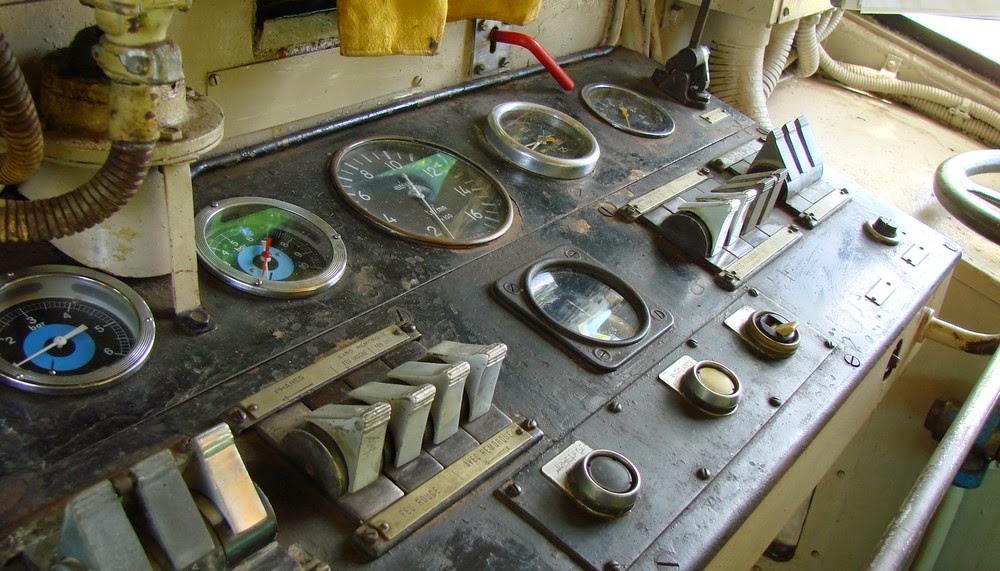ATTCV railcar X-3976 Picasso
 |
| Picasso at Brignoles station |
It's a nice little beast. It weighs 31 tons. Not that heavy, though, compared with many other rail vehicles. It was put into service in April 1956 at the depot in Tours southwest of Paris. It served railway passengers for more than three decades before becoming a member of the tourist railway in Guîtres-Marcenais's rail vehicle collection northeast of Bordeaux.
It arrived to ATTCV's depot in Besse-sur-Issole in April 1996. After five years in Besse it was ready for service under the ATTCV banner. On 19th August 2001 it ran as the Association's inauguration train on the Carnoules - Brignoles tourist train line.
The Picasso was for five years the Association's only railcar in the tourist service, until the arrival of the two Caravelles in 2006 - and the arrival of the "Shoebox" in 2010. Now, she's the grand old lady in a increasing collection of historic railcars and other vehicles, a member of the railway museum at Besse.
 |
| Picasso at Camps-la-Source station |
 |
| Picasso at Carnoules-les-Platanes |
 |
| Picasso at Sainte-Anastasie-sur-Issole station |
 |
| Picasso at Brignoles station |
A total of 251 Picassos were manufactured from 1950 to 1961, identified as X-3801 to X-4051, the first series built by Renault in Choisy-le-Roy, close to Paris; the following by De Dietrich in Reichshoffen, north of Strasbourg in Alsace, and by other factories.
ATTCV has two Picassos, one used for passenger traffic, one as a "spares supply", "mothballed" at the Carnoules station.
Why is it called Picasso?
The most widespread explanation why this type of railcar was given the unofficial name "Picasso" is that the "nose" (the driver's cabin) is not situated where it's expected to be, viz. in the center of the "face". This reminds of Picasso's way of placing body parts in his paintings.The Picassos weigh 31,1 tons at a length of 21.8 m. They are provided with diesel engines, either a Renault 517 (300 or 340 hp) or 575 (360 hp), or a Saurer BXDS (360 hp). The fuel consumption is 30 - 60 liter per 100 km.
It has two passenger compartments, separated by the entrance platform, as well as a bagage compartment and an engine room. A total of 67 passengers can be seated.
Picassos were used by SNCF in six regions until their retirement during the 80-ies (the last was taken out of service in Bordeaux in 1987). Close to 50 of them still exist, some in operation at museum railroads.
 |
| The railcar has two passenger compartments |
 |
| Passengers in the front compartment have a nice view of the tracks |
The association's Picasso carries number X-3976. It was first cut into service on the 9th of April 1956 at Tours. It arrived to Besse 40 years later, in July 1996, after having been with the tourist railway in Guîtres-Marcenais (NE of Bordeaux).
Driver's position
The driver is located in the special cabin above the engine compartment. This placement of the cabin provides him/her with a very good overview and enables driving in either direction without having to change cabin (as is the case with other railcars). He/she sits with his/her back towards the side of the car, with the controls in front of him/her. He/she turns the head left or right to view the tracks in front of or behind the car.
Contrary to railcars with a driver cabin in each end, changing direction is extremely easy. The driver simply turns his head and changes gear. Even more simple than driving a car!
 |
| The driver's control panel |
 |
| 40 kph is the maximum speed on the Carnoules-Brignoles railway line |
 |
| Picasso "cockpit" view |
The Picasso operated by ATTCV has a manual gearbox, with 4 gears without synchronization. Whilst the railcar was permitted to be operated at speeds up to 120 km/h, the maximum speed on the Carnoules - Gardanne line is 40 km/h (which gives passengers the opportunity to better enjoy the villages, fields, vineyards and mountains in this "green" part of Provence).
 |
| The Picasso engine room |


